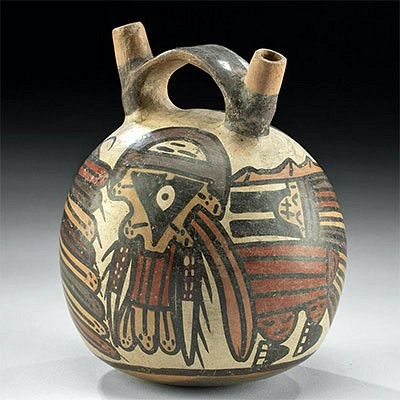Signed 1983 B. Honyouti Wood Hopi Kachina Scene
Lot 139
About Seller
Artemis Fine Arts
686 S Taylor Ave, Ste 106
Louisville, CO 80027
United States
Selling antiquities, ancient and ethnographic art online since 1993, Artemis Gallery specializes in Classical Antiquities (Egyptian, Greek, Roman, Near Eastern), Asian, Pre-Columbian, African / Tribal / Oceanographic art. Our extensive inventory includes pottery, stone, metal, wood, glass and textil...Read more
Categories
Estimate:
$600 - $900
Absentee vs Live bid
Two ways to bid:
- Leave a max absentee bid and the platform will bid on your behalf up to your maximum bid during the live auction.
- Bid live during the auction and your bids will be submitted real-time to the auctioneer.
Bid Increments
| Price | Bid Increment |
|---|---|
| $0 | $25 |
| $300 | $50 |
| $1,000 | $100 |
| $2,000 | $250 |
| $5,000 | $500 |
| $10,000 | $1,000 |
| $20,000 | $2,500 |
| $50,000 | $5,000 |
| $100,000 | $10,000 |
| $200,000 | $20,000 |
About Auction
By Artemis Fine Arts
Feb 10, 2022
Set Reminder
2022-02-10 10:00:00
2022-02-10 10:00:00
America/New_York
Bidsquare
Bidsquare : Ancient & Ethnographic Art Through The Ages
https://www.bidsquare.com/auctions/artemis-gallery/ancient-ethnographic-art-through-the-ages-8873
Join us for Part Two of a spotlight on two fabulous collections, one from Lumberton, Texas, and the other from Whisnant Gallery in New Orleans. Artemis Fine Arts info@artemisgallery.com
Join us for Part Two of a spotlight on two fabulous collections, one from Lumberton, Texas, and the other from Whisnant Gallery in New Orleans. Artemis Fine Arts info@artemisgallery.com
- Lot Description
Brian Honyouti (Native American, Hopi Pueblo, 1947-2016). Wood and paint. Hand-signed and dated "B. Honyouti 83" in pigment by artist on base. A wonderful wooden statue of 2 people pleading with a kachina spirit. Wielding a knife in his right hand, the kachina stands on bent legs and grasps the hand and arm of a person who kneels before him as though pleading. The indigenous spirit wears an elaborate, black helmet mask with projecting eyes, large, red ears pierced with spikes, a protruding snout, and a gritted jaw with jagged teeth, all capped with wooden feathers and fiber strands of black hair. His body is dressed in a tan cape, a colorful loincloth, an armband, a bracelet, fringed knee adornments, and leather boots. Another person wearing pigtails and a loincloth watches the interaction, as they sit to the side with knees drawn up before them. Size: 4.6" W x 6.3" H (11.7 cm x 16 cm)
The Katsinam, supernatural beings who live in the high mountains of the San Francisco Peaks above traditional Hopi territory, speak to the Hopi through costumed dance and song. These dancers emerge from the round ceremonial kivas that are at the center of their communities, singly or in groups, and dance to the music of drums, rattles, and song. Katsina figures (katsina dolls, katsin-tihu), are made of cottonwood root to represent these supernatural beings. Cottonwood is culturally symbolic because the cottonwood tree, once abundant in traditional Hopi lands, grows where water flows - thus, looking across a landscape, lines of cottonwood trees denote a water source in the desert. After carving, the figures are painted all over with whitewash, made from kaolin clay, and then painted with other colors.
Brian Honyouti was one of 3 famous Hopi brothers - the others being Loren and Ronald Honyouti - who often carved together. Originally from Bacavi, Arizona, the Honyoutis are featured in many books on Hopi carving, including "Kachina Dolls" by Helga Tiewes and "The Art of the Hopi" by Jerry and Lois Jacka. Brian began carving the mid-1960s and is the first carver to use wood preservatives and varnish as a sealer, instead of the usual white undercoat.
Provenance: private Lumberton, Texas, USA collection, acquired before 2010
All items legal to buy/sell under U.S. Statute covering cultural patrimony Code 2600, CHAPTER 14, and are guaranteed to be as described or your money back.
A Certificate of Authenticity will accompany all winning bids.
PLEASE NOTE: Due to recent increases of shipments being seized by Australian & German customs (even for items with pre-UNESCO provenance), we will no longer ship most antiquities and ancient Chinese art to Australia & Germany. For categories of items that are acceptable to ship to Australia or Germany, please contact us directly or work with your local customs brokerage firm.
Display stands not described as included/custom in the item description are for photography purposes only and will not be included with the item upon shipping.
#169601Losses to 1 pigtail of each seated figure. Expected nicks and abrasions throughout, commensurate with age. Otherwise, excellent with nice pigments.Condition
- Shipping Info
-
All shipping is handled in-house for your convenience. Your invoice from Artemis Gallery will include shipping calculation instructions. If in doubt, please inquire BEFORE bidding for estimated shipping costs for individual items.
-
- Buyer's Premium



 EUR
EUR CAD
CAD AUD
AUD GBP
GBP MXN
MXN HKD
HKD CNY
CNY MYR
MYR SEK
SEK SGD
SGD CHF
CHF THB
THB
















